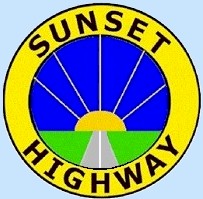
The Historic Sunset Highway
in Washington
State Road No. 7

The Historic Sunset Highway
in Washington
State Road No. 7
State Road No. 7 and the Sunset Highway
In 1897, an attempt was made to build a new road between Lake Keechelus and Easton. The existing trail was widened to allow the passing of wagons. This new road was built on the north side of the Yakima River close to the path of today’s Interstate 90. This 14 mile section had steep grades of 25% to 30% and was poorly constructed. Because of the poor construction and lack of maintenance, by 1905 only 5 miles of this 14 mile road was still passable by a wagon. This road was abandoned for the new State Road No. 7.
In the 1900's Easton was the farthest an automobile could get to from the east during the winter months. To get to the Puget Sound, autos were shipped on the railroad. Both the Milwaukee Road and the Northern Pacific, both had rail yards and loaded and unloaded autos there. By 1931, the highway was kept open all year around and the rails were no longer needed to ship cars over the pass.
The 1908 State Highway Biennial Report shows that beginning at Easton and extending 5 miles west, a new road had been completed at a cost of $20,800. There was 6.4 miles of additional road that was about 50% completed in 1908 and the cost of this section was a little more than $11,000 so far. There was a steel bridge across the Kachess River near Easton with a span of 100 feet and was completed during the winter of 1908 at a cost of $2,873. The total cost for construction of those 11.4 miles was $34,673.00.
By 1910, the new State Road No. 7 was complete between The southern end of Lake Keechelus and Easton. This section of highway had a maximum grade of 5%. The roadbed was graded 19 feet wide in the cuts and 20 feet wide on the embankments. The Commissioner expected the road would be subjected to heavy summer travel so it was constructed in the most substantial manner.
In 1928, the highway was improved and a new road was constructed between Lake Keechelus and Easton. This new road smoothed out the curved and straightened the roadway and eliminated the need for a switchback on the hill west of Easton.